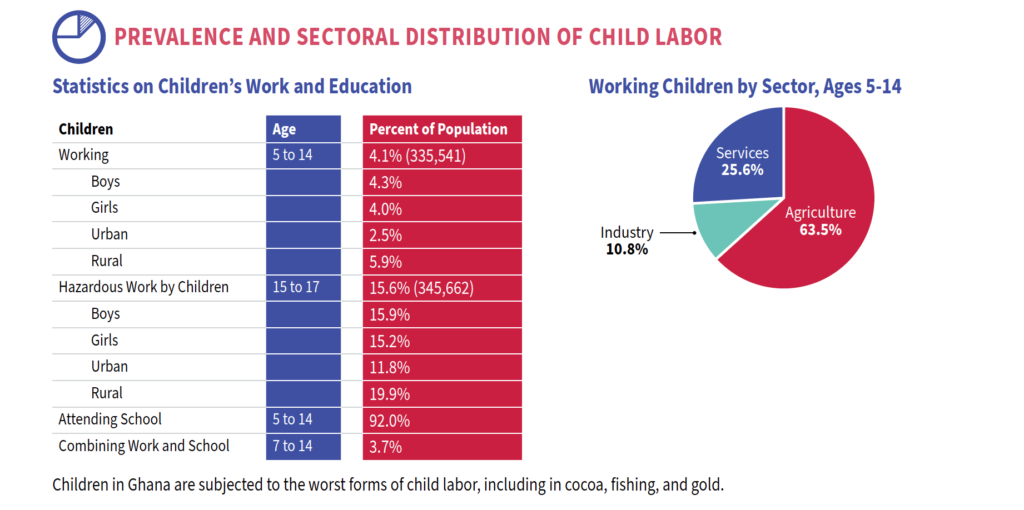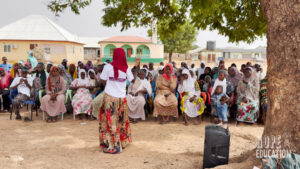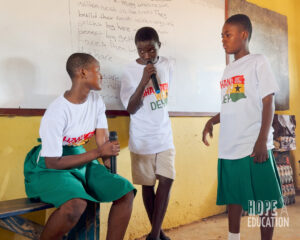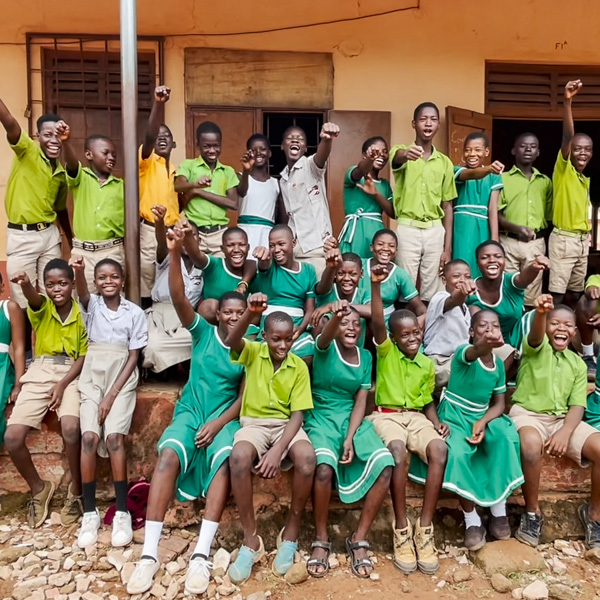Tackling Child Labour and Trafficking in Ghana: A Fight for the Future
Child labour and human trafficking are deeply intertwined issues in Ghana, particularly affecting vulnerable children in industries such as cocoa farming, fishing, gold mining, and in the case of kayaye – young female porters – working in urban markets. The 2023 Findings on the Worst Forms of Child Labor report, published on September 5, 2024, by the U.S. Department of Labor, highlights Ghana’s ongoing challenges in eradicating these exploitative practices. Despite some progress, the report finds that much more needs to be done to protect children from the dangers of trafficking and forced labour.
The Findings on the Worst Forms of Child Labor (WFCL) report is mandated by the Trade and Development Act of 2000 and submitted to Congress by the Bureau of International Labor Affairs (ILAB) on behalf of the Secretary of Labor. It assesses the efforts of countries and territories in addressing child labour, highlighting issues such as lack of access to quality education, declines in primary school completion rates, and insufficient financial investment in projects designed to combat child labour. It also outlines key actions that governments can take, including increased funding for social programs, stronger legislation, and better enforcement.
In the 2023 Findings on the Worst Forms of Child Labor report, the “worst forms of child labour” are defined as per ILO Convention No. 182. These forms include:
- All forms of slavery or practices similar to slavery: This encompasses the sale and trafficking of children, debt bondage, serfdom, and forced or compulsory labour, including the forced recruitment of children for armed conflict.
- Use, procuring, or offering of children for prostitution: This includes child pornography and pornographic performances.
- Use of children in illicit activities: Specifically for the production and trafficking of drugs.
- Hazardous work: Any work that, by its nature or the conditions in which it is carried out, could harm the health, safety, or morals of children.
The Kayayei Phenomenon: A Hidden Crisis of Child Labour in Ghana
One of the most vulnerable groups in Ghana are the kayaye—young girls, primarily from rural northern regions, who migrate to cities like Accra and Kumasi in search of work. These girls work as head porters, carrying heavy loads in bustling urban markets. Many kayaye live in extremely precarious conditions, often sleeping on the streets, which makes them especially vulnerable to trafficking for sexual exploitation and other forms of abuse.
For many kayaye, the move to urban centres is driven by a lack of educational opportunities, poverty, and cultural pressures from their home regions. Tragically, their migration often leads to increased exploitation, with some girls forced into transactional sex or trafficked for sexual exploitation.
Trafficking of Children for Labour and Exploitation
In addition to the kayaye crisis, children in Ghana are trafficked both within the country and internationally for forced labour in hazardous industries. Key sectors include:
- Cocoa Farming
In cocoa farming, children are trafficked to work on plantations, where they face dangerous tasks such as clearing land with machetes and handling toxic pesticides. - Fishing on Lake Volta
On Lake Volta, children are trafficked into forced labour, where they engage in perilous fishing activities such as diving underwater to untangle nets. Many of these children are trapped in a cycle of exploitation. - Gold Mining
Trafficked children are forced to work in artisanal mines, where they dig in hazardous pits, handle mercury, and operate dangerous machinery. - Commercial Sexual Exploitation
In addition to being trafficked for sexual exploitation, many children in Ghana face growing risks of Online Child Sexual Exploitation and Abuse (OCSEA). According to the ECOWAS 2023 report, internet use among children in Ghana spiked from 10% in 2010 to 73% in 2021, leading to increased vulnerability online. Sexting and sharing of self-generated sexual content have become prevalent among high school students. Ghana saw a 72% increase in Child Sexual Exploitation and Abuse Material (CSEAM) from 2019 to 2022, indicating the urgent need for stronger protections.
Government Efforts and Challenges: Tackling Child Labour in Ghana
The 2023 report found that Ghana has made some progress in tackling child labour and trafficking. The government launched the Ghana Accelerated Action Plan Against Child Labor in 2023 and conducted over 1,290 labour inspections, a 12% increase from 2022. The government also conducted investigations into suspected cases of the worst forms of child labour, initiated 9 prosecutions, and convicted 7 perpetrators. However, the report found that challenges remain, particularly in the enforcement of laws against trafficking.
The 2023 Findings on the Worst Forms of Child Labor report identifies several key areas for improvement, including the need for increased funding for social programs and stronger enforcement of child labour laws. The report also highlights the need for better access to education and social programs, as well as addressing economic factors that drive children into the workforce.
The report advocates for the following government actions to eliminate child labour in Ghana:
Legal Framework:
- Accede to the UN Convention on the Rights of the Child Optional Protocol on the Sale of Children, Child Prostitution, and Child Pornography.
- Criminally prohibit the use of children in illicit activities, including drug production and trafficking.
- Prohibit the recruitment of children under age 18 by non-state armed groups.
- Update the hazardous work list for children to align with ILO C. 182.
Enforcement:
- Increase the number of labour inspectors from 179 to 969 for adequate coverage of the labour force.
- Strengthen and fully fund the mechanism for tracking child labour cases and referrals between law enforcement and social services.
- Ensure inspectors and investigators have adequate resources, including office space, transportation, and supplies.
- Ensure trained prosecutors oversee cases involving the worst forms of child labor, and increase the number of state attorneys available to prosecute.
- Improve communication and coordination among enforcement agencies to prosecute cases and provide adequate victim support.
- Utilize the Trafficking in Persons Information System and publish related activities.
Government Policies:
- Implement government policies related to child labour and publish activity data annually, including the Hazardous Child Labor Activity Framework.
- Provide necessary resources for the National Plan of Action for the Elimination of Human Trafficking in Ghana.
Social Programs:
- Improve access to education by eliminating school-related fees, increasing classrooms, providing sanitation facilities, and preventing sexual harassment and physical violence in schools.
- Ensure vocational training opportunities for secondary school students enrolled in the dual-track system.
- Expand shelter services for child survivors and ensure that all shelters are operational.
- Replicate and expand the Child Labor Monitoring System, and establish programs to address child labor in the cocoa, fishing, and mining sectors.
Education and Awareness: A Solution to Child Trafficking
Education is one of the most effective tools to combat child labour and trafficking. Programs like the Hope Education Project (HEP) aim to raise awareness about human trafficking in vulnerable communities. By educating children and their families about the dangers of trafficking, these programs help to disrupt the cycle of exploitation.
The report found that the government’s Ghana School Feeding Program has been instrumental in increasing school attendance, which reduces the risk of children being trafficked or forced into labour. In 2023, the program fed over 3.4 million pupils, helping to keep them in school and out of the labour force.
A Call for Action
The fight against child labour and trafficking in Ghana has some considerable way to go. It requires not only stronger laws and enforcement but also addressing the root causes of poverty, lack of education, and cultural norms that perpetuate exploitation. Through collective efforts from the government, NGOs, and local communities, Ghana can take significant strides towards eradicating child trafficking, particularly for vulnerable groups like the kayaye, ensuring a safer, brighter future for its children.
